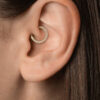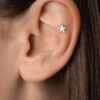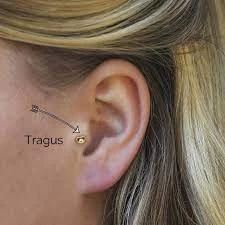Body piercings have been a form of self-expression and fashion statement for centuries. Hoop piercings are popular for enhancing appearance, making a statement. This article provides all info needed to make informed decision about getting one.
What are Hoop Piercings?
Hoops piercing, also called captive bead rings, are circular jewelry inserted into skin through a puncture and fastened with a small bead. Made of materials such as stainless steel, titanium, gold, or bioplast, they come in various diameters and gauges.
Where Can You Get a Hoop Piercing?
Hoops piercing can go anywhere on the body, with popular areas being the ears, nose, navel, lip, and tongue. It’s important to note that some piercings may not be suitable for everyone and may not heal properly in some areas due to different anatomy. It’s always best to consult with a professional piercer to determine the best placement for your individual needs and comfort level.
How is a Hoop Piercing Done?
A professional piercer performs a Hoop piercing using a sterile needle. Insert the needle into the skin, place the hoop through the hole, and fasten the bead to secure the hoop. The entire process usually takes just a few minutes and is relatively painless. It’s important to choose a reputable piercer and make sure they follow proper safety and sanitation procedures to reduce the risk of infection.
Healing and Aftercare
The healing process for a hoop piercing can take anywhere from 4 to 8 weeks, depending on the location and individual healing time. During this time, it’s important to follow proper aftercare instructions to reduce the risk of infection and ensure proper healing. This includes cleaning the piercing with saline solution, avoiding touching the piercing with unclean hands, and avoiding swimming and other activities that may expose the piercing to bacteria.
Benefits of Hoop Piercings
One of the main benefits of hoop piercings is that they are versatile and can be dressed up or down to fit any occasion. They come in a variety of sizes, styles, and materials, making it easy to find the perfect one for your individual needs and style. Additionally, hoops piercings can enhance your appearance, drawing attention to your features and adding a touch of personality and flair to your look.
Risks of Hoop Piercings
While hoop piercings are generally safe and pose minimal risk, there are a few potential side effects to be aware of. These may include infection, keloid scarring, and rejection. To reduce the risk of these side effects, it’s important to choose a reputable piercer and follow proper aftercare instructions. Additionally, be sure to watch for any signs of infection, such as redness, swelling, and discharge, and seek medical attention if necessary.
Choosing the Right Hoop Piercing
When choosing a hoop piercing, there are several factors to consider. These may include the material of the hoop, the gauge, the diameter, and the style. It’s important to choose a reputable piercer who can help you make an informed decision and ensure that the hoop you choose is the right size and style for your individual needs and anatomy.
Conclusion
In conclusion, Hoops piercing: trendy, versatile, and popular. Can go anywhere on the body. Varying sizes, styles, materials. Choose reputable piercer, follow aftercare for safe healing. Minimal risk, but watch for side effects, signs of infection. Consider material, gauge, diameter, style when choosing hoop. Fun and unique way to express, enhance appearance.




























